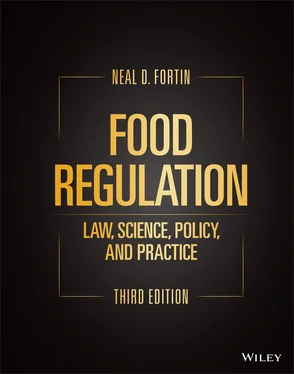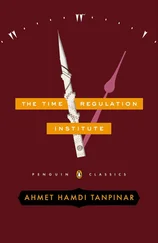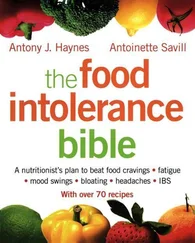Neal D. Fortin - Food Regulation
Здесь есть возможность читать онлайн «Neal D. Fortin - Food Regulation» — ознакомительный отрывок электронной книги совершенно бесплатно, а после прочтения отрывка купить полную версию. В некоторых случаях можно слушать аудио, скачать через торрент в формате fb2 и присутствует краткое содержание. Жанр: unrecognised, на английском языке. Описание произведения, (предисловие) а так же отзывы посетителей доступны на портале библиотеки ЛибКат.
- Название:Food Regulation
- Автор:
- Жанр:
- Год:неизвестен
- ISBN:нет данных
- Рейтинг книги:4 / 5. Голосов: 1
-
Избранное:Добавить в избранное
- Отзывы:
-
Ваша оценка:
- 80
- 1
- 2
- 3
- 4
- 5
Food Regulation: краткое содержание, описание и аннотация
Предлагаем к чтению аннотацию, описание, краткое содержание или предисловие (зависит от того, что написал сам автор книги «Food Regulation»). Если вы не нашли необходимую информацию о книге — напишите в комментариях, мы постараемся отыскать её.
Food Regulation: Law, Science, Policy, and Practice
Food Regulation: Law, Science, Policy, and Practice, Third Edition,
Food Regulation — читать онлайн ознакомительный отрывок
Ниже представлен текст книги, разбитый по страницам. Система сохранения места последней прочитанной страницы, позволяет с удобством читать онлайн бесплатно книгу «Food Regulation», без необходимости каждый раз заново искать на чём Вы остановились. Поставьте закладку, и сможете в любой момент перейти на страницу, на которой закончили чтение.
Интервал:
Закладка:
6 6 See, e.g., 21 U.S.C. § 610(c) (regarding transportation in commerce of without complying with inspection and marking provisions).
7 7 88 Stat. 1660 (1974).
8 8 The Nutrilab court references are to the United States Code (U.S.C.) sections rather than the FDCA sections. Note that this U.S.C. citation was created by dropping the middle digit and putting a 3 in the hundred's digit; thus, 201 becomes 321. Most, but not all, FDCA section are codified into the U.S.C. this way.
9 9 Refer to Section 2.1.1above for the definition of “drug,” in particular, (g)(1)(C).
10 10 United States v. 250 Jars … Cal's Tupelo Blossum U.S. Fancy Pure Honey, 344 F.2d 288 (6th Cir. 1965).
11 11 Sterling Vinegar and Honey, 338 F.2d 157 (2d Cir. 1964).
12 12 United States v. Hohensee, 243 F.2d 367 (3d. Cir. 1957).
13 13 United States v. 500 Plastic Bottles … Wilfrey's Bio Water (D. Or. 1989).
14 14 United States v. Kollman (DC Or. 1985, 1986).
15 15 United States v. Articles of Drug … Neptone (ND Cal. 1983).
16 16 National Nutritional Foods Ass'n v. Mathews, 57 F.2d 325 (2d Cir. 1977).
17 17 Id.
18 18 United States v. Green Coffee Beans, 188 F.2d 355 (1951).
19 19 United States v. Tomahara Enterprises, Ltd. (DC ND N.Y. 1983).
20 20 United States v. Technical Egg Prods., Inc., 171 F. Supp. 326 (N.D. Ga. 1959).
21 21 See 21 U.S.C. § 321(s).
22 22 See, Natick Paperboard Corp. v. Weinburger, 525 F.2d 1103 (1st Cir. 1975).
3 FOOD LABELING

3.1 INTRODUCTION
Labeling, perhaps surprisingly, has been at the center of many aspects of food regulation. Incorrect labeling consistently ranks as the leading cause of food recalls and import denials. This chapter examines food labeling regulation that is designed to protect the economic expectations of both consumers and the food industry. In Chapter 4, we will cover the regulation of the nutritional content and labeling of food. In Chapter 8, we will cover the regulation of the identification of foods in more depth, including the standards of identity requirements and the requirement for common and usual names.
The food labeling requirements designed to protect economic expectations cover both prohibitive and affirmative regulation. The prohibitive requirements protect against fraud and deception. Prevention of false and misleading statements is at the historical foundation of labeling regulation. On the other hand, the affirmative requirements mandate that food manufacturers provide information on their labels that they otherwise might not include.
The affirmative requirements are intended to provide consumers with information they need to make informed choices about the food. What information has been deemed material to informed choice is a surprisingly small set that has remained relatively stable.
This chapter provides:
1 an overview of the labeling laws,
2 the basic knowledge needed to review a label for compliance with applicable requirements,
3 knowledge of where to look up answers, and
4 identification of reference materials.
3.2 LEGAL AUTHORITIES
FDA’s authority to compel the labeling of food products primarily derives from the Food, Drug, and Cosmetic Act (FD&C Act). Many of the statutory labeling requirements come from section 403 of the FD&C Act, which lists circumstances when a food will be considered “misbranded.” The definition of “misbranded” contains the major misbranding requirements:
1 Mandatory labeling of the name of the food, ingredient statement, net quantity, and the name and address of the manufacturer or distributor.
2 Mandatory standards of identity.
3 Labeling of imitation foods.
4 Nutrition information for special dietary foods.
5 Prohibition of any false or misleading claims.
The Fair Packaging and Labeling Act (FPLA), 15 U.S.C. 1451 et seq ., was enacted in 1966 to prevent unfair and deceptive trade practices, and to provide consumers with accurate information regarding the quantity and value of products. The FPLA is administered by the FDA for labels on foods, drugs, and cosmetics, while the Federal Trade Commission (FTC) administers the FPLA for most other consumer commodities.
FDA’s labeling regulations are located in 21 C.F.R. 101 and cover both the requirements of the FD&C Act and the FPLA.
Labeling of meat, poultry, and egg products is regulated under separate laws by the United States Department of Agriculture (USDA). The major principles and many of the specifics are the same in both sets of requirements. This chapter provides an overview of the differences.
3.3 LABELING TERMINOLOGY
* * * * *
Federal Food, Drug, and Cosmetic Act
Chapter II—Definitions
SEC. 201. [321]For the purposes of this Act—
….
1 (k)The term “label” means a display of written, printed, or graphic matter upon the immediate container of any article; and a requirement made by or under authority of this Act that any word, statement, or other information appearing on the label shall not be considered to be complied with unless such word, statement, or other information also appears on the outside container or wrapper, if any there be, of the retail package of such article, or is easily legible through the outside container or wrapper.
2 (l)The term “immediate container” does not include package liners.
3 (m)The term “labeling” means all labels and other written, printed, or graphic matter (1) upon any article or any of its containers or wrappers, or (2) accompanying such article….
* * * * *
Food Labeling
21 C.F.R. Part 101
§ 101.1 Principal display panel of package form food
The term “ principal display panel ” as it applies to food in package form and as used in this part, means the part of a label that is most likely to be displayed, presented, shown, or examined under customary conditions of display for retail sale. The principal display panel shall be large enough to accommodate all the mandatory label information required to be placed thereon by this part with clarity and conspicuousness and without obscuring design, vignettes, or crowding. Where packages bear alternate principal display panels, information required to be placed on the principal display panel shall be duplicated on each principal display panel ….
§ 101.2 Information panel of package form food
1 The term “information panel” as it applies to packaged food means that part of the label immediately contiguous and to the right of the principal display panel as observed by an facing the principal display panel with the following exceptions:If the part of the label immediately contiguous and to the right of the principal display panel is too small to accommodate the necessary information or is otherwise unusable label space, e.g., folded flaps or can ends, the panel immediately contiguous and to the right of this part of the label may be used.If the package has one or more alternate principal display panels, the information panel is immediately contiguous and to the right of any principal display panel.If the top of the container is the principal display panel and the package has no alternate principal display panel, the information panel is any panel adjacent to the principal display panel.
2 All information required to appear on the label of any package of food under … this chapter shall appear either on the principal display panel or on the information panel, unless otherwise specified by regulations in this chapter.
Читать дальшеИнтервал:
Закладка:
Похожие книги на «Food Regulation»
Представляем Вашему вниманию похожие книги на «Food Regulation» списком для выбора. Мы отобрали схожую по названию и смыслу литературу в надежде предоставить читателям больше вариантов отыскать новые, интересные, ещё непрочитанные произведения.
Обсуждение, отзывы о книге «Food Regulation» и просто собственные мнения читателей. Оставьте ваши комментарии, напишите, что Вы думаете о произведении, его смысле или главных героях. Укажите что конкретно понравилось, а что нет, и почему Вы так считаете.












